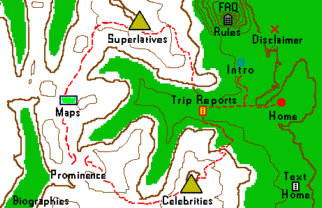
| Indiana Road Naming Conventions *1-2 |

|
When traveling county roads in Indiana, you will routinely see Convention 1
one of two different naming conventions adopted by the various counties.
The location of many Indiana intersecting roads is easy to find from wherever you are due to this standardized naming system that many counties use.
The system is designed to aid emergency response vehicles (fire trucks, ambulances, police cars) to find the exact location of rural addresses. It mirrors the 4-quadrant grid (the Cartesian plane) of analytic geometry and named after the late, great René Descartes.
Each county designates one intersection as the (0,0) point of the road system - the origin. Each road traveling east-west is given a qualifier "N" or "S" depending on whether it lies north or south of the midline. Similarly, each road traveling north-south is given a qualifier "W" or "E" depending on whether it lies west or east of the midline.
The township system of naming geographic sections lends itself nicely to such a naming system. Since townships are broken down into 36 sections of 1 square mile each, the township roads that separate each section can be easily named "CR 200N" or "CR 700E" to indicate the roads that lie 2 miles north or 7 miles east of the roads passing through the origin, respectively.
Addresses are described by their Cartesian coordinates. For example, the address 725E 1200N lies 7 1/4 miles east of the north-south midline road (and 1/4 mile east of CR 700E); and 12 miles north of the east-west midline road. This would be an address found in the northeast (NE) quarter of the county.
CR 1300E is 1 mile east of CR 1200E, CR 725N is 1/4 mile north of CR 700N, etc.... In theory, you should never get lost because you always know where you are relative to the midline roads and the origin. Any intersection you reach allows you, by its name alone, to deduce which way to turn for reaching your destination.
The only occasional complication to this system is that,
without a county roadmap, you will not know
which roads dead-end and which roads continue far
enough to get you to your desired location.
However, if you get stuck, simply backtrack and try the
next road. This logical system is easy to navigate
if you do not have maps of everything.
Convention 2
The second system of naming roads is used, for example, in DeKalb and Elkhart Counties. Starting in the northwest corner of the county, the east-west roads are named using even numbers, and the north-south roads are named using odd numbers. Numbers increase the farther east or south you go. With this knowledge, you can know that DeKalb CR 4, for example, is north of CR 12. Similarly, CR 13 is west of CR 79.
I donít know the following with confidence. In DeKalb County, I noted that the roads 1 mile apart had name differences of 4 units. As examples, I observed that CR 2 was 0.5 mile south of the county line; CR 4 was 0.5 mile south of CR 2, CR 8 was 1 mile south of CR 4; and CR 16 was 1 mile south of CR 12. This suggests that each unit represents a 1/4 mile of distance. I will keep this in mind as I visit future counties that use this convention, or see if I can verify this fact through other means.